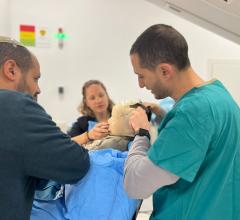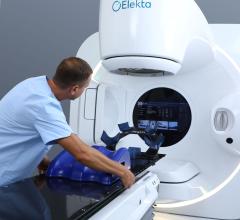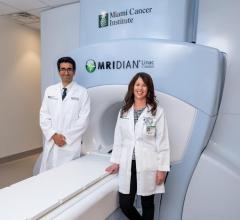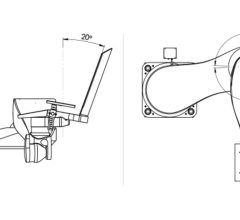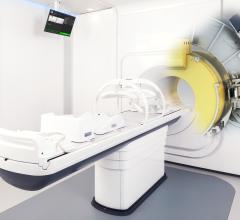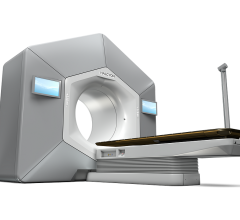
Outside View of BCCC
For the Memphis, TN-based Baptist Centers for Cancer Care’s Radiation Oncology Center (BCCC ROC), providing high-quality cancer treatment and customer service translates to not only leading the local and regional pack clinically, competitively and technologically but also consistently.
Declining reimbursement, a faltering economy, competitive threats from other area hospitals as well as internal diversification and competition within its own parent organization have complicated matters. But they haven’t clouded the center’s vision, dampened the dedication and enthusiasm of the staff nor forced them to retreat to the status quo. Quite the contrary.
Being an early adopter, being first in the metropolitan area to implement the latest advances in radiation oncology, remains its modus operandi, according to Karen McGraner, director, BCCC ROC.
“Our organization is committed to its vision and re-invests in its technology,” McGraner said. “However, our challenge is to be our region’s early adopter as budgets decrease or if there are any changes in referral patterns. As any organization proceeds through its capital planning processes, our needs compete not only with other services within our entity and organization, but also with the needs of other radiation oncology centers in our organization.”
Historically, BCCC ROC bills itself as the first in the area to offer freestanding prostate brachytherapy with intraoperative dosimetry, three-dimensional high-dose rate brachytherapy, intensity-modulated radiation therapy (IMRT), image-guided radiation therapy (IGRT), respiratory gating and linear accelerator-based stereotactic radiosurgery (SRS) and stereotactic radiotherapy (SRT).
In fact, within the last two years, BCCC ROC invested more than $5 million in equipment, the addition of a new HDR treatment area, upgrading its existing accelerator consoles to 4DTC and electronic medical record software as well as computer hardware, McGraner noted.
“The investment in technology fits into the vision of our organization,” she said, “to ‘be a comprehensive cancer program dedicated to clinical excellence and compassionate cancer care.’ To provide clinical excellence the investment in technology is required.”
“We believe that strategically being an early adopter of new technologies within our area provides us increased consumerism,” McGraner continued. “Clinically, as championed by our medical director, Jea Lee, M.D., our goal is to provide cutting-edge technology that increases quality and decreases toxicities, and impacts the overall response of the patient’s tumor response to treatment, therefore also distinguishing the services that you provide, as compared to your competitors.”
McGraner cited the facility’s “strong” gynecologic service and new SRS/SRT program as two examples of Dr. Lee’s drive for clinical success. “We project that we will provide over 730 HDR treatments during this year, [which is] at the current rate of referral, but anticipate an increased referral pattern. We also have been encouraged by the initiation of our SRS/SRT program, and the physician champions [in radiation oncology, neurosurgery, thoracic surgery and medical oncology] who have become involved,” she said. “Initially, we were conservative when forecasting our volume. We have been pleased with the referral pattern for this service, and realized an 80 percent increase from initial conservative projections.” The facility also recorded a 7 percent increase in IMRT volume.
Such breadth and depth of service, motivation and tenacity and dedication to patients as true customers inspired Outpatient Care Technology magazine to bestow its 2008 Outpatient Excellence Award for Oncology Centers on BCCC ROC.
Leading on the technology edge
To carry out its vision of operating as a center of clinical excellence, BCCC ROC requires leading-edge technology, according to McGraner. “We are committed to providing the best patient care with the best technology,” she said. “Our technology provides us with the most efficient method to treat our patients, and do so in a safe, accurate and productive manner.”
The multimillion-dollar investment in capital equipment and technology, bolstered by increased patient volume from existing and new services, seems to be a rewarding financial risk – not only for the patients but also for the facility itself. Return on investment for the new technology installed just last year is approximately 26 months, McGraner calculated. That includes a brachytherapy suite, IGRT and EMR. “To this end technology is a key driver, and one that we strive to keep up with in this day,” she added.
McGraner admitted that they didn’t start out planning for such an extensive technology acquisition spread. Back in 2006, they began strategic planning to replace an older accelerator so they could offer IGRT and SRS/SRT. “Although our clinical and support teams looked at several vendors’ equipment, it became clear to us that the addition of a Trilogy [by Varian Medical Systems] would not only allow us to have an accelerator that would support our goals [and] objectives, but would also allow us to beam-match the machine to allow flexibility of transfer of patients between our equipment as the need arose,” she said. “We also felt that an added benefit was that the Trilogy would allow us the flexibility to use the machine as ‘simple’ as we needed to, or as ‘complex’ as we needed to.”
The decision to add the Trilogy fueled a succession of others with a goal to improve efficiencies and processes with new equipment and new functionality. What began with a need to replace an older accelerator led to building a new brachytherapy suite, remodeling a treatment room and installing a Trilogy. Evaluating an EMR system emerged next on the list.
“Limitations existed with kV matching and transfer of the cone-beam computed tomography (CBCT) with our existing EMR, although it had served us quite well since 1993,” McGraner noted. “We then evaluated our existing EMR and ARIA in order to choose the software that would provide optimal long-term clinical and documentation needs. We also then evaluated the Eclipse [treatment planning system]. We choose to move to a single vendor and integrated environment as it became evident that we would benefit from not only quality but also inherent operational efficiencies. We removed import and export of critical data used in the planning and treatment of our patients across the multi-vendor environment.
“We were committed to provide quality, safety and accuracy,” she continued. “By removing redundancies, manual entries, import/export of key elements within our systems for planning soon became evident and allowed us to achieve those goals. The technical staff was thrilled to see the ease with which patients could move between treatment units. The beams were matched and further data entry was no longer required. We also work with other hospitals within our organization to move critical patient information between systems.”
Before 2006, BCCC ROC operated three accelerators, and two of them were not equipped with updated technology, including multileaf
collimator (MLC), portal vision (PV) dosimetry and IGRT capabilities. “We looked at multiple vendors and their equipment could have provided us with other alternatives, but it was important to us to make a sound, cost-effective decision that would allow us to not only replace an older accelerator but to enter the IGRT, SRS/SRT and gating markets,” McGraner noted. “The Trilogy allowed us to meet those objectives, while also beam-matching the Trilogy with our other accelerators. The acquisition of the Trilogy provided us greater flexibility with existing equipment.”
In fact, BCCC ROC maintains a favorable longstanding relationship with Varian Medical Systems that includes linear accelerators, HDR brachytherapy, prostate brachytherapy seed planting, simulators, radiotherapy planning and EMR software. It uses GE Healthcare for computed tomography (CT) and positron emission tomography (PET/CT) imaging; C.R. Bard for radioactive material for the ProSeed prostate brachytherapy implant technique; B-K Medical for ultrasound; PAR Scientific A/S for block cutters; Scanditronix Wellhofer for physics calibration equipment; and CIVCO Medical Solutions for immobilization devices and treatment supplies.
But McGraner’s team doesn’t operate in a vacuum at the Baptist system. For example, the radiation oncology team participated in the evaluation of PET/CT scanners alongside the diagnostic radiology department. “We work well with the MRI, CT and PET/CT teams when our physicians order diagnostic tests, as the imaging will later be used for treatment planning purposes,” she said. “Our medical physicists and technical team work to ensure accurate positioning, scanning geometry.”
Another hospital within the Baptist organization plans to install a Trilogy and duplicate the integrated environment used by BCCC ROC. “As an organization we understand the difficulty in recruiting highly skilled/knowledge workers, such as medical physicists and dosimetrists,” McGraner noted. “We hope that with integration of equipment across our system that remote dosimetry will now be an option/solution for future staffing challenges and for patients moving across our system.” In addition, the Baptist system can generate considerable savings on capital and service/support contracts, as well as maintain the integrity and security of sensitive patient data as it’s transmitted throughout the organization when patients transfer between system healthcare facilities.
With this integrated technology environment, including customized electronic forms in the EMR system, BCCC ROC recorded increased clinical and IT-related financial efficiencies, removed redundant processes, improved productivity and eliminated waste, according to McGraner, who estimated that they have decreased total expenses by approximately 23 percent.
Completing the whole
BCCC ROC currently is a department of the nonprofit Baptist Memorial Health Care Corp., which comprises 15 hospitals throughout Tennessee, Mississippi and Arkansas, and six radiotherapy facilities, among other nonacute care facilities. Baptist Memorial Hospital – Memphis represents the flagship and largest hospital of the corporation on whose campus BCCC ROC resides. As a result, often a patient’s diagnosis and treatments start at the flagship facility before moving to another center close to home where radiotherapy is completed, according to McGraner.
But BCCC ROC wasn’t always so tightly intertwined with Baptist Memorial. In 1993, Baptist Centers for Cancer Care initially opened as a joint venture between a physician group and Baptist Memorial Health Care Corp. as the Mid-South’s first freestanding radiation oncology center. Physicians from competing practices joined together to form a partnership in the venture. But the Stark II changes passed by Congress and enacted in 1995 forced some changes in the initial radiation oncology center structure, McGraner indicated. Three years later, BCCC became a hospital department even as it remained a freestanding facility, but it ended the relationship with the partnering physicians from competing practices.
The organization’s payer mix is approximately 50 percent Medicare, 37 percent commercial and 13 percent Medicaid and self-pay.
“Regardless where the patient is in the continuum of the cancer experience, from diagnosis to cure or end-of-life, specialized care is available within the oncology service line,” McGraner said. “Our service line consists of many who provide the multidisciplinary team to care for the cancer patient, which is beneficial.”
A dedicated ambulance team transports hospital inpatients to the center, which is located next to a hotel that can serve as a convenient stop for out-of-town patients and their families and friends.
BCCC ROC clearly grasps a fundamental understanding of patient satisfaction and customer service. “It takes a team, individually and collectively, that is committed to providing customer-focused care,” McGraner emphasized. “Committed is the key word. It takes a team of individuals to excel at patient satisfaction – from the secretary at the front desk who smiles and greets the patient, to the therapists and nurses who daily provide warm and compassionate care to the patients, to the physicians who take the time to address the patients’ needs, and to all those working behind the scenes to make sure all systems are working.
“Our team members meet one on one with the patients to welcome them to our care setting and provide the appropriate education,” she continued. “It is our goal that we understand their expectations and take the time to listen. Our team members understand the patients’ expectations, and, anticipate them. Every staff member is accountable for providing the necessary education, allowing time to reinforce any issues that the patient may feel remains unresolved.”
Staff provide educational and support programs, and personally provide flowers, cards, treats and gifts for a variety of special programs and holidays; music and art therapy also are offered; and blankets are kept warm to wrap around or lay over a patient. When a patient completes a therapy course, the staff award him or her with a “congratulations certificate” signed by all.
“Simply put, patient satisfaction occurs when everyone merely remembers the golden rule, educates the patients, keeps the patient informed and follows through on every step,” McGraner said. “It truly makes one proud when you watch your team celebrate patient birthdays, or help patients with their wigs or dress – just because they care. [At the time of the interview] All of our teams were excited as the wife of a young male patient of ours gave birth. He kept in touch with our team during labor and after delivery – not to communicate his appointment time, but because our staff was celebrating with him and his family!”
McGraner emphasized the ROC team’s dedication to provide a patient-centered environment, serving patients “each and every day straight from their hearts – just like the Tin Man in the Wizard of Oz,” she said. “They practice the appropriate distance from our patients, necessary to provide accurate care, but know how to touch their spirit and emotions to help them with the challenges of their diseases.”
Furthermore, she noted how empowered the team became during the last year. “They were not only a part of every decision during all of our transitions this past year, but they were the solution,” she said. “Because of shared values within the complete team a new sense of trust, caring and respect among all staff empowered everyone. As we built our ARIA EMR, as we anticipated planning methods for new techniques, as we practiced new techniques with dry runs, our staff themselves grew in their individual roles/professions. We had champions within our team, working to complete and fit all of the pieces of the new puzzle together. For example, Medical Physicist Kevin Bronson clearly was integral to the process, working with the software to verify accuracy, while also working with the staff to implement the new techniques. Several members of our therapy team and office teams worked to complete a database conversion.
“We have evidenced decreased wait times, decreased treatment times, decreased planning times and increased efficiencies, increased employee satisfaction, and a new sense of renewed self-worth and contribution at every step of our processes as a result of our team’s direct engagement,” she continued.
Accountability helps to drive the process, according to McGraner.
“We continue to analyze strategic objectives and evaluate the needs of our patients, our technology, new services to adopt, the environment and our competition on an ongoing basis,” she said. “Our organization holds all employees to be good stewards of its resources – patients, staff, operations, processes, productivity and supplies. Standards are set to plan and monitor our investment, ongoing expenses and ROI. During all meetings, for management or staff, we all follow the strategy to communicate new issues, but patient volumes, productivity, quality improvement and patient satisfaction are always addressed – all key to financial well-being.”
BCCC ROC by the Numbers
Administrator: Karen McGraner, director
Web site: www.bmhcc.org/facilities/memphis/services/cancer/
Clinical Staff: 3.0 FTE Physicians
3.0 FTE radiation oncologists
2.0 FTE physicists
1.0 FTE dosimetrists (1 vacant position)
1.0 FTE lead radiation therapist
9.8 FTE radiation therapists
2.0 FTE clinical/nursing staff (e.g., nurses, physician assistants)
2.0 FTE clerical support (e.g., secretarial, reception)
BCCC works with sister hospitals to provide services to patients by sharing a medical physicist, dosimetrist and therapists. Medical oncologists are in private practice; radiologists are contracted by the hospital.
Administrator/Business Operations staff (e.g., finance, HR, IT)
Office staff performs direct admissions of our patients. Hospital’s admission team works to pre-certify patients. Hospital documentation review and business office teams work with facility. BCCC works with corporate IS/IT project teams for ongoing support of programs and with hospital IS/IT team for ongoing support of hardware and its functionality.
Scope of Services:
• External beam radiotherapy (IMRT, IGRT)
• Stereotactic radiosurgery and radiotherapy
• HDR and LDR brachytherapy
• Clinical research
• Genetics program
• Stem cell transplant program
• Cancer navigators
• Comprehensive breast center (including FFDM)
• Inpatient hospice
• Palliative care
Annual Volumes:
787 patients treated
13,669 annual treatments (accelerator)
729 annual treatments (HDR)
Source: BCCC, July 2008


 June 14, 2024
June 14, 2024 


